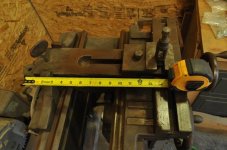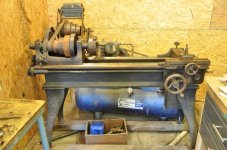The "thumbscrew" at the back of the carriage is made to give a "rise & fall" tool rest. This before the day of insert tooling and adjustable rocker lantern/toolposts.
Rise & fall is now almost forgotten as a turning expedient. But back in the day of hand forged tools, the capability could come in handy. This is cutting carbon steel with carbon steel tools - which means the tool didn't have much of an advantage over the work being cut.
Carbon steel tool steel in the 19th century was almost entirely a British thing. The glassmakers of England had experience and a head start in making tool steels and commanded the American markets until well after the Civil War.
Thus tool steel for pre Civil War Americans was imported, expensive, and usually worked to size/contour manually on site by the machinist to do the lathe work.
A cut that begins to "bog down" could be nursed to the end by changing the height of the tool slightly, without having to resort to making a new tool - usually while the lathe was in motion. Thus changing the angle of attack of the tool and possibly "easing" the cut (or making it worse and bogging it down entirely?)
The other 19th century development was the use of the "feed rod" (rather than geared lead-screw) for traversing the carriage. The feed rod was usually driven by a three or four stepped pulley and leather belt. It was common to "jump the belt" with the lathe in motion (or even stopped) and thus change the feed - and possibly thereby relieve the cut somewhat. This was Thayer & Houghton's development about 1853 when they "knocked their socks off" at the Worcester Mechanics Exhibition (held annual and frequently more often at Mechanic Hall in Worcester.)
Unlike today with our quick change, high speed steel or carbide, and even the greater speeds, the 19th century was a time that the machinist took a very direct command of the process. To say it was "interactive" would be understating it.
This Pratt & Whitney lathe a little late to have the rise & fall. By the time Pratt & Whitney were putting their name on the side of the lathe beds, compound rests were much the rage. But also by this time P&W had grown somewhat "conservative" - both in their standard fare, and in what they would make on demand for their mostly New England clientele - who themselves tended to be conservative.
Note that the cross-slide saddle rides in "dovetails." I'll wager the rise & fall thumbscrew is "captive" where it attaches to the carriage - thus the saddle is held in place without a dangling weight and instead counts on mechanical connection to the weight of the carriage/apron assembly to hold it to the shears.
Other than the absence of a weight, the three point support arrangement is very much like my Shepard, Lathe & Co. lathe - and the concept of three point support of the carriage goes back to Wilkinson.
Joe in NH








